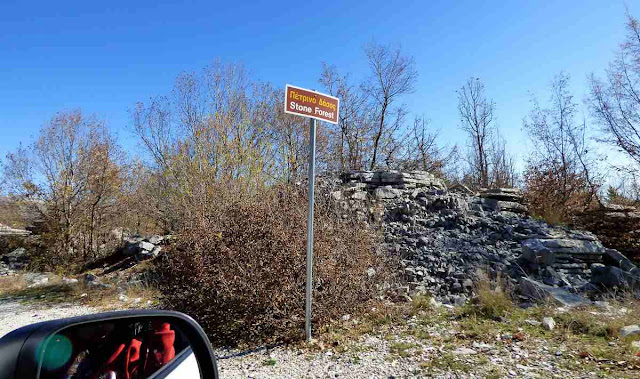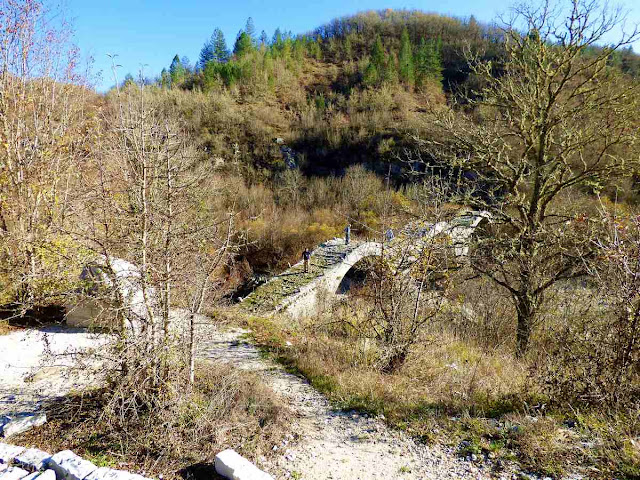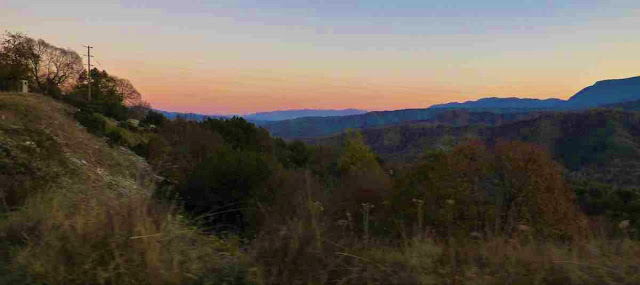DAY 4, Nov 12, 2018, Monday:
Our next destination was Monodendri in
the Zagori region.
Zagori (Greek: Ζαγόρι), is a
region in the Pindus mountains in Epirus, in
northwestern Greece The name “Zagori” is Slavic and
means “beyond the mountains”. A cluster of 48
traditional picturesque villages in this region were
interconnected by mountain roads and traditional arched stone bridges
until modern roads were opened in the 1950s.
These were the places we covered in our
2 day stay in this beautiful mountainous region.
https://goo.gl/maps/LhziwUh9LL42
https://goo.gl/maps/LhziwUh9LL42
From Meteora we had an early start and had a drive of 133 km to Hotel Matzato in Monodendri. It took a while as these are windy roads.
We had conflicting directions from our hotel and the people in the town. We were asked to go through Kalabaka but we did not. We topped up the car's gas tank as there are no gas pumps in the Zagori area. [No ATMs either, so carry cash.]
We chose Monodendri as our base out of
the 40 plus villages as it's central, small and picturesque and easy
to cover rest of the area from.
It was foggy, but the weather cleared
as we approached our destination. The sky in the Zagori region was a
startling bright blue with not even a whiff of cloud. It stayed that
way the entire 2 days. The appropriate caption for our Zagori stay
would be....
BRIGHT BLUE SKIES, BLAZING SUN, BITING COLD BREEZE AND BEAUTIFUL VIEWS
Hotel Matato, Monodendri:
Had an early check in at our hotel. It is up a flight of steps. Spacious room with kitchen facilities and a balcony with lovely
views.
Vikos Gorge:
We started our drive toward the north to the oxia view point to enjoy the famous Vikos canyon.
Vikos Gorge is located in the province
of Epirus in the region known as Zagorochoria. It is recorded as the
world’s deepest canyon 900 meters deep in Guinness book of records
in 1997. The Vikos Gorge is a 20 km long gorge between the villages of
Monodendri and Vikos. The average depth of the gorge is 700 meters
but its highest point is 1600 meters. Its width varies from 450
meters to just a few meters; indeed the deepest canyon in proportion
to its width.
The Vikos Gorge is at 990 m
deep near Monodendri and 1350 m near its end. The Vikos Gorge is
also a site of major scientific interest, because it is in almost
virgin condition.
Stone forest (Petrodasos):
On the way to Oxia a viewpoint of Vikos
gorge, we passed the stone forest (Petrodasos), which is a natural
monument with rocky formations with horizontal layers of stone.
Stone forest (Petrino dasos) competes
with the oak and maple forest. It’s an area of impressively
developed karstic field at an altitude of 1,500 meters. Thin layers
of Eocene limestone are carved by water and the wind, having as
guides the cracks opened by the rectangular fault system.
We were really impressed with the
geometric precision of these stone formations.
Cows walked by with their calves, bells
tinkling. Lovely pastoral scene.
Oxia Viewpoint:
Finally we reached the panoramic view from Oxia to Vikos and Megas Lakkos Canyons. At this site limestone dates back to 35 million years and at the base of the Canyon limestone dates back to 160 million years. A gigantic slash ran deep into the limestones which rise up perpendicularly as if they were about to lean.
Nice sight.
Villages:
We then retraced our way back to
Monodendri and went south to enjoy the other villages. First was
Vitsa. Lovely views which have not translated even a bit in our
pics/videos.
There are many roadside monuments like this... probably for accident victims??
Historical bridges
Until the fifties of the 20th century the stone-arched bridges that criss-cross the Zagori region played a vital role in linking communities. Today, many of these bridges, which date from the 18th and 19th centuries, can be seen from the modern roadside.
More than 160 arched bridges were built in the greater area of Zagori, many of which still stand helping travelers to cross the countless rivers and streams of the region. They were mostly built during the 18th and 19th centuries by local master craftsmen who used the local stone as material.
These bridges usually have one to three arches called "kamares" in Greek. The stone arched bridges were built by benefactions from expatriate merchants in the 18th century and replaced older wooden bridges.
Kokkori Or Noutsos Bridge:
Vradeto stairs (Skala tou Vardetou):
The famous Stairs of
Vradeto connected the village Vradeto with Kapesovo and the rest
of the world until the 70s. The total distance between Vradeto and
Kapesovo, near where the stairs lead is approximately 3.5 km. More
than 1,000 cobblestone stairs smoothly covering an altitude
difference of 250 m...A stone construction using “indigenous”
stone with which renowned craftsmen built and linked the two
villages! It took 20 years to build in early 18th century. Three
lanes, one for animals with black stones and two for people with
white ones, measured width calculated exactly so that the animals are
able to swivel.
It is now a great hiking trail.
We reached Kapesovo and saw the
signboard.
We parked our car and followed the
trail. It went on and on becoming rough and difficult, with no view of
the start of the stairs.
We could see the stairs zigzaging on the
hill in the distance. Though we could see no easy way to reach it
We
reluctantly decided to turn back. We thought it'll be easy to access from
Vradeto. We drove on
Reached the entrance point there. Again similar story. We walked and walked but could not even see the stairs.
We turned back, drove on toward Beloi viewpoint. All through, it was a very scenic drive
Reached Beloi point. It was gravel for the last 2 km which we did not want to drive on in our rental. Board said 30 minute walk one way.
Dusk was settling in. We were a little scared of bears too.Zagori roads have very sharp switchbacks and there are no guard rails. We did not want to drive back in the dark on these roads.
Sky was being painted in a rosy orange glow...
We turned back home very satisfied with the scenic beauty we had enjoyed! Not too much regret for our misses.
Enjoyed moon rise from our room balcony and retired for the night
VIDEO LINK:
Zagori day 1 video is here:


























































































No comments:
Post a Comment